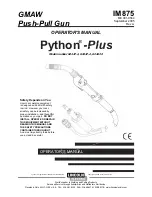
9
REEVING LOAD CHAIN
Installing a new length of load chain
To replace the load chain, remove the lower hook block and
chain stop from the chain. Move the directional lever to the
neutral “N” and pull the old chain out of the hoist. Feed a length
of soft wire through one side of the chain guide roller and over
the liftwheel until it comes out on the other side of the chain
guide roller.
Attach the wire to the end of the new chain. Position the chain
so that the first link to enter the chain guide roller will be an
upstanding link and the welds on all upstanding links will be
away from the liftwheel. Pull on the wire until the chain
engages the liftwheel. Turn the free chaining knob, while pulling
on the wire, until the chain comes out of the chain guide roller.
Pull the chain through and remove the wire. Attach the lower
hook block to the chain that is directly below the upper hook.
Attach the chain stop to the other end of the chain.
TESTING
Prior to initial use, all altered, repaired or used hoists that have
not been operated for the previous 12 months should be tested
by the user for proper operation. Test the unit without a load
and then with a load of 100 pounds (46 Kg) to be sure that the
hoist operates properly and that the brake holds the load when
the lever is released. Then test with a load of 125% of rated
capacity. Hoists in which load sustaining parts have been
replaced should be tested with a load of 125% of rated
capacity by, or under the direction of, an appointed person and
a written report prepared for record purposes.
Figure 8
Timing
Marks
Figure 9
Chain guide
roller-Lower
Hook Side
To reduce the risk of injury, feed load chain between
liftwheel and chain guide before attaching the
warning tubes and end ring. Failure to properly install
the load chain may cause the chain to lift out of the
liftwheel pockets and allow the load to drop.
Stripper
Lower
Hook
Block
Chain Stop-
Position as
Shown
Chain Welds
Away From
Liftwheel
Liftwheel
Chain Guide
Roller-Chain
Stop Side




































